LATIONAMERICAN ART IN KÁRSTICA'24
The Museum of Photography of the Antonio Perez Foundation, at its headquarters in the town of Huete, Cuenca, exhibits part of the results of the artistic residence held at Kárstica Espacio de Creación, in which, during last June, a total of six artists have developed their projects. Among them, there is a strong presence of emerging Latin American names, with up to four representatives. Costa Rica's Mat Kar, winner of an award at the call held by the Spanish Cultural Center in Costa Rica, focuses on the ancestral connection around the plastic research work she carries out on the Paleolithic venus.

For their part, the Puerto Rican group Colectivo Revolú, formed by Marcos Daniel Vicéns, Andrés Meléndez and Miguel Ángel Feba, show their production, which highlights an attempt at a natural union between the tropicalisms of their native Puerto Rico and the geological aspects of the mountains of the Spanish province of Cuenca, which has also provided the necessary materials to execute their works during the residency. Parallel to the technique and the environment, his works also approach social factors such as the processes of climatic conversion or depopulation in rural areas. The exhibition is completed by the works of the Spanish artist Jacqueline Bonacic-Doric and the Madrid artist Black Butter.
Kárstica'24 can be visited until July 14 at FAP Huete – Museum of Photography, Plaza Cristo, 1, Huete, Spain.
Related Topics
May interest you

The Museo Extremeño e Iberoamericano de Arte Contemporáneo (MEIAC) is extending until mid-September the exhibition Las líneas de la vida, by artist Pablo Reinoso (Buenos Aires, Argentina, 1955), which deals with the concept of legacy.
REINOSO'S BIOMORPHISM, AT THE MEIAC
The Museo Extremeño e Iberoamericano de Arte Contemporáneo (MEIAC) is extending until mid-September the exhibition Las líneas de la vida, by artist Pablo Reinoso (Buenos Aires, Argentina, 1955), which deals with the concept of legacy.

The Museo Extremeño e Iberoamericano de Arte Contemporáneo (MEIAC) is extending until mid-September the exhibition Las líneas de la vida, by artist Pablo Reinoso (Buenos Aires, Argentina, 1955), which deals with the concept of legacy.
REINOSO'S BIOMORPHISM, AT THE MEIAC
The Museo Extremeño e Iberoamericano de Arte Contemporáneo (MEIAC) is extending until mid-September the exhibition Las líneas de la vida, by artist Pablo Reinoso (Buenos Aires, Argentina, 1955), which deals with the concept of legacy.
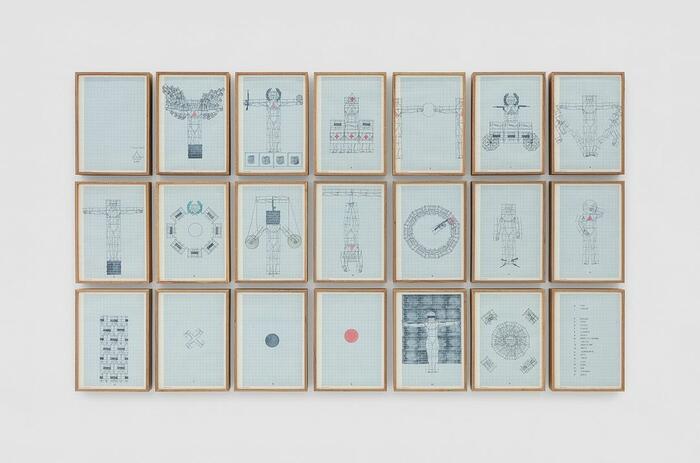
Zielinsky opened a new space in São Paulo, Brazil and presented a solo exhibition by Brazilian artist Claudio Goulart (1954-2000), whose work was developed in Amsterdam, the Netherlands, where he lived for over 30 years until he passed away due to complications from AIDS.
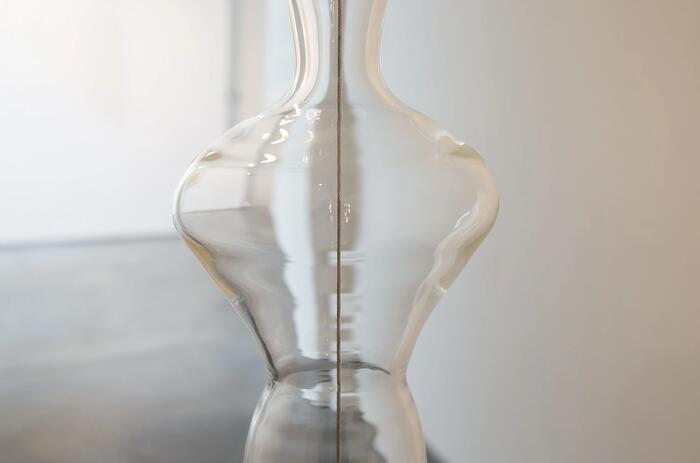
The Madrid-based Max Estrella exhibits in its Project Room space Escuchando la Lluvia (Listening to the Rain), by artist Glenda León (Havana, Cuba, 1976), which also serves as a letter of introduction of the Cuban artist as the gallery's new representative. This piece of enormous stylization is presented as a blown glass sculpture handcrafted by the Royal Glass Factory of La Granja in Segovia that collects a visual representation of a drop of water falling.
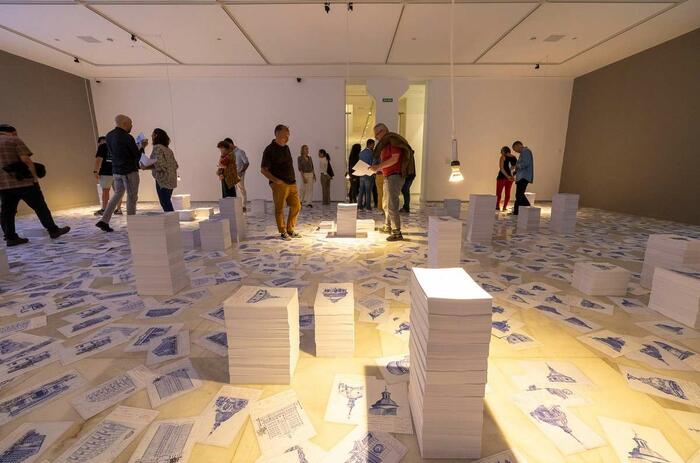
The Centro Atlántico de Arte Moderno (CAAM), located in Las Palmas de Gran Canaria, is hosting the exhibition Toda utopía pasa por la barriga, a tour through the work of Carlos Garaicoa (Havana, Cuba, 1967) curated by Lillebit Fabraga that best connects with architecture, the natural order and the location of the human being in the system.
CARLOS GARAICOA: ARCHITECTURE AND PLACE AT THE CAAM
The Centro Atlántico de Arte Moderno (CAAM), located in Las Palmas de Gran Canaria, is hosting the exhibition Toda utopía pasa por la barriga, a tour through the work of Carlos Garaicoa (Havana, Cuba, 1967) curated by Lillebit Fabraga that best connects with architecture, the natural order and the location of the human being in the system.
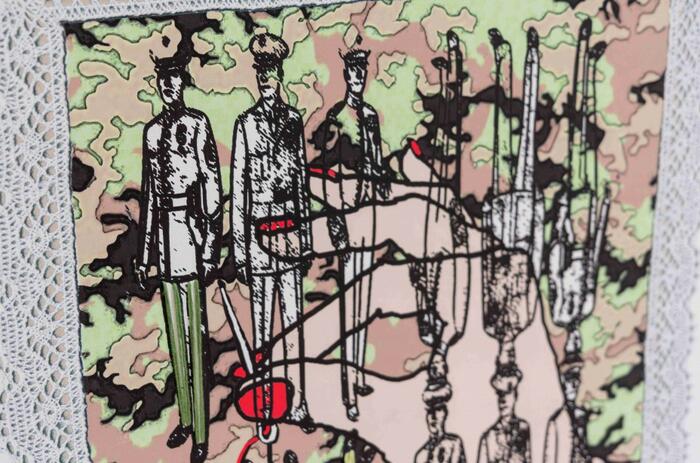
The Canary Islands' TEA (Tenerife Espacio de las Artes) is showing until September Y, a solo exhibition by Nela Ochoa (Caracas, Venezuela, 1953), which is part of the curatorial program Filtraciones that the center carries out for artists and with its collection.
THE OTHERNESS OF THE BODY, ACCORDING TO NELA OCHOA, IN TEA
The Canary Islands' TEA (Tenerife Espacio de las Artes) is showing until September Y, a solo exhibition by Nela Ochoa (Caracas, Venezuela, 1953), which is part of the curatorial program Filtraciones that the center carries out for artists and with its collection.
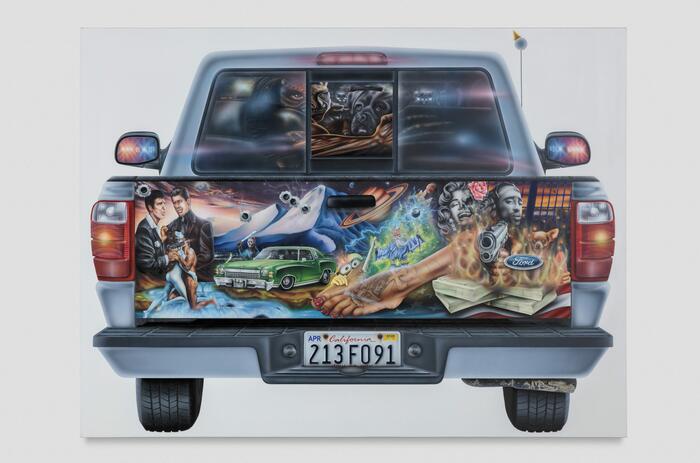
The CAC Malaga hosts Milagro, the first solo exhibition in a museum of Mario Ayala (Los Angeles, USA, 1991), son of a Mexican-American mother and Cuban immigrant father, whose production reflects his personal experiences and artistic concerns of the world of garages, truck drivers and mechanics of Fontana.
CAC MALAGA HOSTS MARIO AYALA'S FIRST SOLO EXHIBITION IN A MUSEUM
The CAC Malaga hosts Milagro, the first solo exhibition in a museum of Mario Ayala (Los Angeles, USA, 1991), son of a Mexican-American mother and Cuban immigrant father, whose production reflects his personal experiences and artistic concerns of the world of garages, truck drivers and mechanics of Fontana.
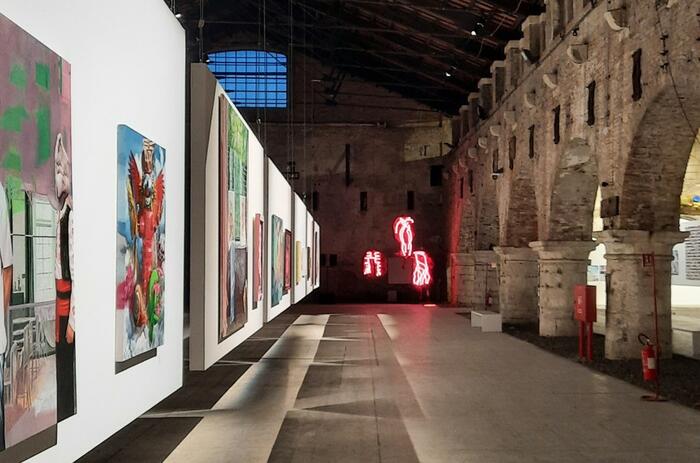
Arte Laguna Prize is a contemporary art competition for artists of all ages, nationalities and artistic backgrounds, regardless of gender and with free subject matter. The competition offers numerous opportunities for participating artists to expand their network, gain international visibility and access valuable resources for the development of their careers. Deadline to apply: July 31, 2024.
ARTE LAGUNA PRIZE: CALL FOR ARTISTS AND DESIGNERS
Arte Laguna Prize is a contemporary art competition for artists of all ages, nationalities and artistic backgrounds, regardless of gender and with free subject matter. The competition offers numerous opportunities for participating artists to expand their network, gain international visibility and access valuable resources for the development of their careers. Deadline to apply: July 31, 2024.
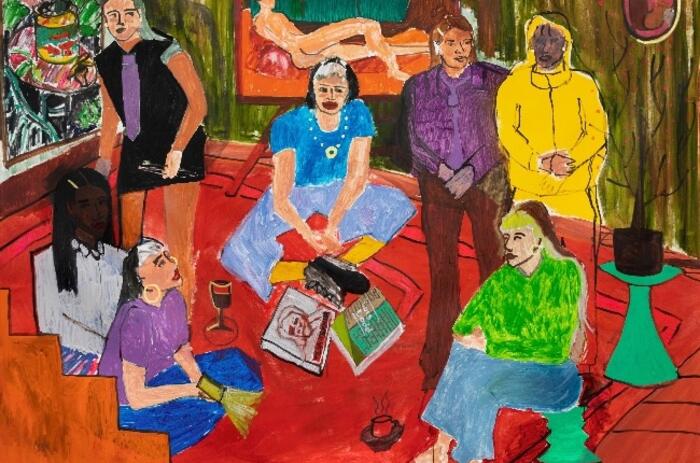
Álbum de Casi Todos (Album of Almost Everyone) is the solo exhibition of Chilean artist Pablo Linsambarth at the Instituto Cultural Peruano Norteamericano (ICPNA). It is curated by Daniel H. Rey.
THE STORIES OF PABLO LINSAMBARTH AT ICPNA
Álbum de Casi Todos (Album of Almost Everyone) is the solo exhibition of Chilean artist Pablo Linsambarth at the Instituto Cultural Peruano Norteamericano (ICPNA). It is curated by Daniel H. Rey.
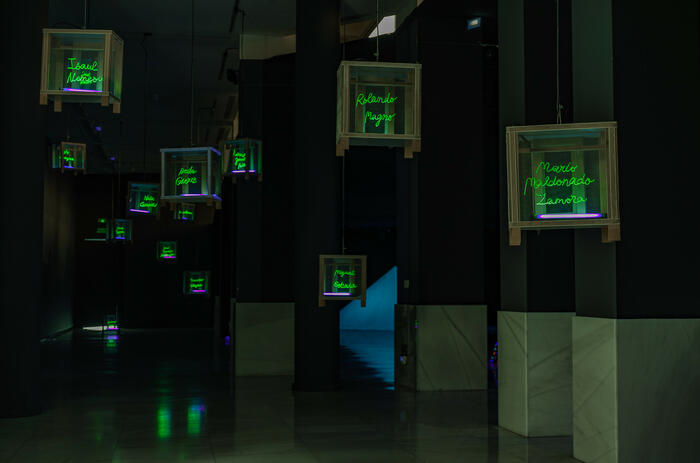
Austrian-born artist Eva Lootz (Vienna, Austria, 1940) has been living in Spain for more than half her life, where she has established herself not only as one of the great names of contemporary art in the country, where she was awarded the National Prize of Plastic Arts, but also in the whole international European panorama. A regular in exhibitions and public interventions, she now assaults Madrid with a double institutional presence with two large-format exhibitions at the Sala Alcala 31 and the Reina Sofia Museum.
EVA LOOTZ ASSAULTS MADRID
Austrian-born artist Eva Lootz (Vienna, Austria, 1940) has been living in Spain for more than half her life, where she has established herself not only as one of the great names of contemporary art in the country, where she was awarded the National Prize of Plastic Arts, but also in the whole international European panorama. A regular in exhibitions and public interventions, she now assaults Madrid with a double institutional presence with two large-format exhibitions at the Sala Alcala 31 and the Reina Sofia Museum.

The international photography festival PHOTOEspaña proposes a program of exhibitions that evoke, both in concept and subject matter, a breadth and diversity that have led to its recognition for years. However, one of its most appreciated improvements has been the expansion of venues and cities, which allows for a wider and better offer.
PAZ ERRÁZURIZ IN THE FUNDACIÓN MAPFRE COLLECTIONS
The international photography festival PHOTOEspaña proposes a program of exhibitions that evoke, both in concept and subject matter, a breadth and diversity that have led to its recognition for years. However, one of its most appreciated improvements has been the expansion of venues and cities, which allows for a wider and better offer.
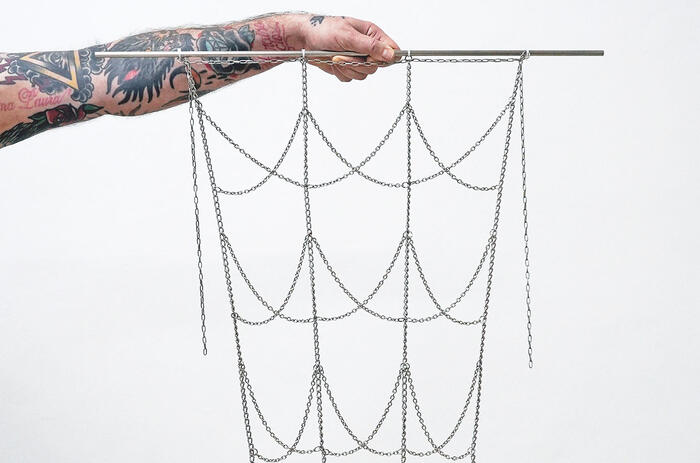
Soy Palacio / Soy Establo is the proposal conceived by Ana Laura Aláez (Bilbao, Spain, 1964) for one of the spaces of the Balearic Museum Es Baluard and in which she proposes, as an intervention, an express dialogue with emptiness.
ES BALUARD HOSTS ANA LAURA ALÁEZ'S DIALOGUE WITH EMPTINESS
Soy Palacio / Soy Establo is the proposal conceived by Ana Laura Aláez (Bilbao, Spain, 1964) for one of the spaces of the Balearic Museum Es Baluard and in which she proposes, as an intervention, an express dialogue with emptiness.
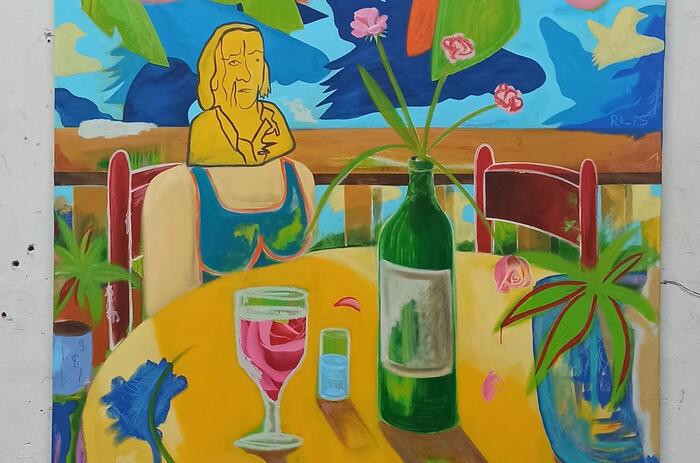
The birth of a new collective is always good news, and it is so for several reasons. Firstly, because of the existence of collective dynamics that bring together different points of view and, second, because, in a didactic way, it contributes to illustrate and understand the current cartographies of art. For the Revolú collective, formed by Andrés Meléndez (San Juan, Puerto Rico, 1996), Miguel Ángel Feba (San Juan, Puerto Rico, 1994) and Marcos Daniel Vicéns (Bayamón, Puerto Rico, 1996), their first exhibition experience is the result of an artistic residency in which, almost blindly, they have been able to build those specific ties to start from the individual and reach the group identity.
GENESIS AND BORICUA RESONANCES IN REVOLÚ
The birth of a new collective is always good news, and it is so for several reasons. Firstly, because of the existence of collective dynamics that bring together different points of view and, second, because, in a didactic way, it contributes to illustrate and understand the current cartographies of art. For the Revolú collective, formed by Andrés Meléndez (San Juan, Puerto Rico, 1996), Miguel Ángel Feba (San Juan, Puerto Rico, 1994) and Marcos Daniel Vicéns (Bayamón, Puerto Rico, 1996), their first exhibition experience is the result of an artistic residency in which, almost blindly, they have been able to build those specific ties to start from the individual and reach the group identity.

The Museo Extremeño e Iberoamericano de Arte Contemporáneo (MEIAC) is extending until mid-September the exhibition Las líneas de la vida, by artist Pablo Reinoso (Buenos Aires, Argentina, 1955), which deals with the concept of legacy.
REINOSO'S BIOMORPHISM, AT THE MEIAC
The Museo Extremeño e Iberoamericano de Arte Contemporáneo (MEIAC) is extending until mid-September the exhibition Las líneas de la vida, by artist Pablo Reinoso (Buenos Aires, Argentina, 1955), which deals with the concept of legacy.

Zielinsky opened a new space in São Paulo, Brazil and presented a solo exhibition by Brazilian artist Claudio Goulart (1954-2000), whose work was developed in Amsterdam, the Netherlands, where he lived for over 30 years until he passed away due to complications from AIDS.

The Madrid-based Max Estrella exhibits in its Project Room space Escuchando la Lluvia (Listening to the Rain), by artist Glenda León (Havana, Cuba, 1976), which also serves as a letter of introduction of the Cuban artist as the gallery's new representative. This piece of enormous stylization is presented as a blown glass sculpture handcrafted by the Royal Glass Factory of La Granja in Segovia that collects a visual representation of a drop of water falling.

The Centro Atlántico de Arte Moderno (CAAM), located in Las Palmas de Gran Canaria, is hosting the exhibition Toda utopía pasa por la barriga, a tour through the work of Carlos Garaicoa (Havana, Cuba, 1967) curated by Lillebit Fabraga that best connects with architecture, the natural order and the location of the human being in the system.
CARLOS GARAICOA: ARCHITECTURE AND PLACE AT THE CAAM
The Centro Atlántico de Arte Moderno (CAAM), located in Las Palmas de Gran Canaria, is hosting the exhibition Toda utopía pasa por la barriga, a tour through the work of Carlos Garaicoa (Havana, Cuba, 1967) curated by Lillebit Fabraga that best connects with architecture, the natural order and the location of the human being in the system.

The Canary Islands' TEA (Tenerife Espacio de las Artes) is showing until September Y, a solo exhibition by Nela Ochoa (Caracas, Venezuela, 1953), which is part of the curatorial program Filtraciones that the center carries out for artists and with its collection.
THE OTHERNESS OF THE BODY, ACCORDING TO NELA OCHOA, IN TEA
The Canary Islands' TEA (Tenerife Espacio de las Artes) is showing until September Y, a solo exhibition by Nela Ochoa (Caracas, Venezuela, 1953), which is part of the curatorial program Filtraciones that the center carries out for artists and with its collection.

The CAC Malaga hosts Milagro, the first solo exhibition in a museum of Mario Ayala (Los Angeles, USA, 1991), son of a Mexican-American mother and Cuban immigrant father, whose production reflects his personal experiences and artistic concerns of the world of garages, truck drivers and mechanics of Fontana.
CAC MALAGA HOSTS MARIO AYALA'S FIRST SOLO EXHIBITION IN A MUSEUM
The CAC Malaga hosts Milagro, the first solo exhibition in a museum of Mario Ayala (Los Angeles, USA, 1991), son of a Mexican-American mother and Cuban immigrant father, whose production reflects his personal experiences and artistic concerns of the world of garages, truck drivers and mechanics of Fontana.

Arte Laguna Prize is a contemporary art competition for artists of all ages, nationalities and artistic backgrounds, regardless of gender and with free subject matter. The competition offers numerous opportunities for participating artists to expand their network, gain international visibility and access valuable resources for the development of their careers. Deadline to apply: July 31, 2024.
ARTE LAGUNA PRIZE: CALL FOR ARTISTS AND DESIGNERS
Arte Laguna Prize is a contemporary art competition for artists of all ages, nationalities and artistic backgrounds, regardless of gender and with free subject matter. The competition offers numerous opportunities for participating artists to expand their network, gain international visibility and access valuable resources for the development of their careers. Deadline to apply: July 31, 2024.

Álbum de Casi Todos (Album of Almost Everyone) is the solo exhibition of Chilean artist Pablo Linsambarth at the Instituto Cultural Peruano Norteamericano (ICPNA). It is curated by Daniel H. Rey.
THE STORIES OF PABLO LINSAMBARTH AT ICPNA
Álbum de Casi Todos (Album of Almost Everyone) is the solo exhibition of Chilean artist Pablo Linsambarth at the Instituto Cultural Peruano Norteamericano (ICPNA). It is curated by Daniel H. Rey.

Austrian-born artist Eva Lootz (Vienna, Austria, 1940) has been living in Spain for more than half her life, where she has established herself not only as one of the great names of contemporary art in the country, where she was awarded the National Prize of Plastic Arts, but also in the whole international European panorama. A regular in exhibitions and public interventions, she now assaults Madrid with a double institutional presence with two large-format exhibitions at the Sala Alcala 31 and the Reina Sofia Museum.
EVA LOOTZ ASSAULTS MADRID
Austrian-born artist Eva Lootz (Vienna, Austria, 1940) has been living in Spain for more than half her life, where she has established herself not only as one of the great names of contemporary art in the country, where she was awarded the National Prize of Plastic Arts, but also in the whole international European panorama. A regular in exhibitions and public interventions, she now assaults Madrid with a double institutional presence with two large-format exhibitions at the Sala Alcala 31 and the Reina Sofia Museum.

The international photography festival PHOTOEspaña proposes a program of exhibitions that evoke, both in concept and subject matter, a breadth and diversity that have led to its recognition for years. However, one of its most appreciated improvements has been the expansion of venues and cities, which allows for a wider and better offer.
PAZ ERRÁZURIZ IN THE FUNDACIÓN MAPFRE COLLECTIONS
The international photography festival PHOTOEspaña proposes a program of exhibitions that evoke, both in concept and subject matter, a breadth and diversity that have led to its recognition for years. However, one of its most appreciated improvements has been the expansion of venues and cities, which allows for a wider and better offer.

Soy Palacio / Soy Establo is the proposal conceived by Ana Laura Aláez (Bilbao, Spain, 1964) for one of the spaces of the Balearic Museum Es Baluard and in which she proposes, as an intervention, an express dialogue with emptiness.
ES BALUARD HOSTS ANA LAURA ALÁEZ'S DIALOGUE WITH EMPTINESS
Soy Palacio / Soy Establo is the proposal conceived by Ana Laura Aláez (Bilbao, Spain, 1964) for one of the spaces of the Balearic Museum Es Baluard and in which she proposes, as an intervention, an express dialogue with emptiness.

The birth of a new collective is always good news, and it is so for several reasons. Firstly, because of the existence of collective dynamics that bring together different points of view and, second, because, in a didactic way, it contributes to illustrate and understand the current cartographies of art. For the Revolú collective, formed by Andrés Meléndez (San Juan, Puerto Rico, 1996), Miguel Ángel Feba (San Juan, Puerto Rico, 1994) and Marcos Daniel Vicéns (Bayamón, Puerto Rico, 1996), their first exhibition experience is the result of an artistic residency in which, almost blindly, they have been able to build those specific ties to start from the individual and reach the group identity.
GENESIS AND BORICUA RESONANCES IN REVOLÚ
The birth of a new collective is always good news, and it is so for several reasons. Firstly, because of the existence of collective dynamics that bring together different points of view and, second, because, in a didactic way, it contributes to illustrate and understand the current cartographies of art. For the Revolú collective, formed by Andrés Meléndez (San Juan, Puerto Rico, 1996), Miguel Ángel Feba (San Juan, Puerto Rico, 1994) and Marcos Daniel Vicéns (Bayamón, Puerto Rico, 1996), their first exhibition experience is the result of an artistic residency in which, almost blindly, they have been able to build those specific ties to start from the individual and reach the group identity.

The Museo Extremeño e Iberoamericano de Arte Contemporáneo (MEIAC) is extending until mid-September the exhibition Las líneas de la vida, by artist Pablo Reinoso (Buenos Aires, Argentina, 1955), which deals with the concept of legacy.
REINOSO'S BIOMORPHISM, AT THE MEIAC
The Museo Extremeño e Iberoamericano de Arte Contemporáneo (MEIAC) is extending until mid-September the exhibition Las líneas de la vida, by artist Pablo Reinoso (Buenos Aires, Argentina, 1955), which deals with the concept of legacy.

Zielinsky opened a new space in São Paulo, Brazil and presented a solo exhibition by Brazilian artist Claudio Goulart (1954-2000), whose work was developed in Amsterdam, the Netherlands, where he lived for over 30 years until he passed away due to complications from AIDS.

The Madrid-based Max Estrella exhibits in its Project Room space Escuchando la Lluvia (Listening to the Rain), by artist Glenda León (Havana, Cuba, 1976), which also serves as a letter of introduction of the Cuban artist as the gallery's new representative. This piece of enormous stylization is presented as a blown glass sculpture handcrafted by the Royal Glass Factory of La Granja in Segovia that collects a visual representation of a drop of water falling.

The Centro Atlántico de Arte Moderno (CAAM), located in Las Palmas de Gran Canaria, is hosting the exhibition Toda utopía pasa por la barriga, a tour through the work of Carlos Garaicoa (Havana, Cuba, 1967) curated by Lillebit Fabraga that best connects with architecture, the natural order and the location of the human being in the system.
CARLOS GARAICOA: ARCHITECTURE AND PLACE AT THE CAAM
The Centro Atlántico de Arte Moderno (CAAM), located in Las Palmas de Gran Canaria, is hosting the exhibition Toda utopía pasa por la barriga, a tour through the work of Carlos Garaicoa (Havana, Cuba, 1967) curated by Lillebit Fabraga that best connects with architecture, the natural order and the location of the human being in the system.

The Canary Islands' TEA (Tenerife Espacio de las Artes) is showing until September Y, a solo exhibition by Nela Ochoa (Caracas, Venezuela, 1953), which is part of the curatorial program Filtraciones that the center carries out for artists and with its collection.
THE OTHERNESS OF THE BODY, ACCORDING TO NELA OCHOA, IN TEA
The Canary Islands' TEA (Tenerife Espacio de las Artes) is showing until September Y, a solo exhibition by Nela Ochoa (Caracas, Venezuela, 1953), which is part of the curatorial program Filtraciones that the center carries out for artists and with its collection.

The CAC Malaga hosts Milagro, the first solo exhibition in a museum of Mario Ayala (Los Angeles, USA, 1991), son of a Mexican-American mother and Cuban immigrant father, whose production reflects his personal experiences and artistic concerns of the world of garages, truck drivers and mechanics of Fontana.
CAC MALAGA HOSTS MARIO AYALA'S FIRST SOLO EXHIBITION IN A MUSEUM
The CAC Malaga hosts Milagro, the first solo exhibition in a museum of Mario Ayala (Los Angeles, USA, 1991), son of a Mexican-American mother and Cuban immigrant father, whose production reflects his personal experiences and artistic concerns of the world of garages, truck drivers and mechanics of Fontana.

Arte Laguna Prize is a contemporary art competition for artists of all ages, nationalities and artistic backgrounds, regardless of gender and with free subject matter. The competition offers numerous opportunities for participating artists to expand their network, gain international visibility and access valuable resources for the development of their careers. Deadline to apply: July 31, 2024.
ARTE LAGUNA PRIZE: CALL FOR ARTISTS AND DESIGNERS
Arte Laguna Prize is a contemporary art competition for artists of all ages, nationalities and artistic backgrounds, regardless of gender and with free subject matter. The competition offers numerous opportunities for participating artists to expand their network, gain international visibility and access valuable resources for the development of their careers. Deadline to apply: July 31, 2024.

Álbum de Casi Todos (Album of Almost Everyone) is the solo exhibition of Chilean artist Pablo Linsambarth at the Instituto Cultural Peruano Norteamericano (ICPNA). It is curated by Daniel H. Rey.
THE STORIES OF PABLO LINSAMBARTH AT ICPNA
Álbum de Casi Todos (Album of Almost Everyone) is the solo exhibition of Chilean artist Pablo Linsambarth at the Instituto Cultural Peruano Norteamericano (ICPNA). It is curated by Daniel H. Rey.

Austrian-born artist Eva Lootz (Vienna, Austria, 1940) has been living in Spain for more than half her life, where she has established herself not only as one of the great names of contemporary art in the country, where she was awarded the National Prize of Plastic Arts, but also in the whole international European panorama. A regular in exhibitions and public interventions, she now assaults Madrid with a double institutional presence with two large-format exhibitions at the Sala Alcala 31 and the Reina Sofia Museum.
EVA LOOTZ ASSAULTS MADRID
Austrian-born artist Eva Lootz (Vienna, Austria, 1940) has been living in Spain for more than half her life, where she has established herself not only as one of the great names of contemporary art in the country, where she was awarded the National Prize of Plastic Arts, but also in the whole international European panorama. A regular in exhibitions and public interventions, she now assaults Madrid with a double institutional presence with two large-format exhibitions at the Sala Alcala 31 and the Reina Sofia Museum.

The international photography festival PHOTOEspaña proposes a program of exhibitions that evoke, both in concept and subject matter, a breadth and diversity that have led to its recognition for years. However, one of its most appreciated improvements has been the expansion of venues and cities, which allows for a wider and better offer.
PAZ ERRÁZURIZ IN THE FUNDACIÓN MAPFRE COLLECTIONS
The international photography festival PHOTOEspaña proposes a program of exhibitions that evoke, both in concept and subject matter, a breadth and diversity that have led to its recognition for years. However, one of its most appreciated improvements has been the expansion of venues and cities, which allows for a wider and better offer.

Soy Palacio / Soy Establo is the proposal conceived by Ana Laura Aláez (Bilbao, Spain, 1964) for one of the spaces of the Balearic Museum Es Baluard and in which she proposes, as an intervention, an express dialogue with emptiness.
ES BALUARD HOSTS ANA LAURA ALÁEZ'S DIALOGUE WITH EMPTINESS
Soy Palacio / Soy Establo is the proposal conceived by Ana Laura Aláez (Bilbao, Spain, 1964) for one of the spaces of the Balearic Museum Es Baluard and in which she proposes, as an intervention, an express dialogue with emptiness.

The birth of a new collective is always good news, and it is so for several reasons. Firstly, because of the existence of collective dynamics that bring together different points of view and, second, because, in a didactic way, it contributes to illustrate and understand the current cartographies of art. For the Revolú collective, formed by Andrés Meléndez (San Juan, Puerto Rico, 1996), Miguel Ángel Feba (San Juan, Puerto Rico, 1994) and Marcos Daniel Vicéns (Bayamón, Puerto Rico, 1996), their first exhibition experience is the result of an artistic residency in which, almost blindly, they have been able to build those specific ties to start from the individual and reach the group identity.
GENESIS AND BORICUA RESONANCES IN REVOLÚ
The birth of a new collective is always good news, and it is so for several reasons. Firstly, because of the existence of collective dynamics that bring together different points of view and, second, because, in a didactic way, it contributes to illustrate and understand the current cartographies of art. For the Revolú collective, formed by Andrés Meléndez (San Juan, Puerto Rico, 1996), Miguel Ángel Feba (San Juan, Puerto Rico, 1994) and Marcos Daniel Vicéns (Bayamón, Puerto Rico, 1996), their first exhibition experience is the result of an artistic residency in which, almost blindly, they have been able to build those specific ties to start from the individual and reach the group identity.

The Museo Extremeño e Iberoamericano de Arte Contemporáneo (MEIAC) is extending until mid-September the exhibition Las líneas de la vida, by artist Pablo Reinoso (Buenos Aires, Argentina, 1955), which deals with the concept of legacy.
REINOSO'S BIOMORPHISM, AT THE MEIAC
The Museo Extremeño e Iberoamericano de Arte Contemporáneo (MEIAC) is extending until mid-September the exhibition Las líneas de la vida, by artist Pablo Reinoso (Buenos Aires, Argentina, 1955), which deals with the concept of legacy.

Zielinsky opened a new space in São Paulo, Brazil and presented a solo exhibition by Brazilian artist Claudio Goulart (1954-2000), whose work was developed in Amsterdam, the Netherlands, where he lived for over 30 years until he passed away due to complications from AIDS.

The Madrid-based Max Estrella exhibits in its Project Room space Escuchando la Lluvia (Listening to the Rain), by artist Glenda León (Havana, Cuba, 1976), which also serves as a letter of introduction of the Cuban artist as the gallery's new representative. This piece of enormous stylization is presented as a blown glass sculpture handcrafted by the Royal Glass Factory of La Granja in Segovia that collects a visual representation of a drop of water falling.

The Centro Atlántico de Arte Moderno (CAAM), located in Las Palmas de Gran Canaria, is hosting the exhibition Toda utopía pasa por la barriga, a tour through the work of Carlos Garaicoa (Havana, Cuba, 1967) curated by Lillebit Fabraga that best connects with architecture, the natural order and the location of the human being in the system.
CARLOS GARAICOA: ARCHITECTURE AND PLACE AT THE CAAM
The Centro Atlántico de Arte Moderno (CAAM), located in Las Palmas de Gran Canaria, is hosting the exhibition Toda utopía pasa por la barriga, a tour through the work of Carlos Garaicoa (Havana, Cuba, 1967) curated by Lillebit Fabraga that best connects with architecture, the natural order and the location of the human being in the system.

The Canary Islands' TEA (Tenerife Espacio de las Artes) is showing until September Y, a solo exhibition by Nela Ochoa (Caracas, Venezuela, 1953), which is part of the curatorial program Filtraciones that the center carries out for artists and with its collection.
THE OTHERNESS OF THE BODY, ACCORDING TO NELA OCHOA, IN TEA
The Canary Islands' TEA (Tenerife Espacio de las Artes) is showing until September Y, a solo exhibition by Nela Ochoa (Caracas, Venezuela, 1953), which is part of the curatorial program Filtraciones that the center carries out for artists and with its collection.

The CAC Malaga hosts Milagro, the first solo exhibition in a museum of Mario Ayala (Los Angeles, USA, 1991), son of a Mexican-American mother and Cuban immigrant father, whose production reflects his personal experiences and artistic concerns of the world of garages, truck drivers and mechanics of Fontana.
CAC MALAGA HOSTS MARIO AYALA'S FIRST SOLO EXHIBITION IN A MUSEUM
The CAC Malaga hosts Milagro, the first solo exhibition in a museum of Mario Ayala (Los Angeles, USA, 1991), son of a Mexican-American mother and Cuban immigrant father, whose production reflects his personal experiences and artistic concerns of the world of garages, truck drivers and mechanics of Fontana.

Arte Laguna Prize is a contemporary art competition for artists of all ages, nationalities and artistic backgrounds, regardless of gender and with free subject matter. The competition offers numerous opportunities for participating artists to expand their network, gain international visibility and access valuable resources for the development of their careers. Deadline to apply: July 31, 2024.
ARTE LAGUNA PRIZE: CALL FOR ARTISTS AND DESIGNERS
Arte Laguna Prize is a contemporary art competition for artists of all ages, nationalities and artistic backgrounds, regardless of gender and with free subject matter. The competition offers numerous opportunities for participating artists to expand their network, gain international visibility and access valuable resources for the development of their careers. Deadline to apply: July 31, 2024.

Álbum de Casi Todos (Album of Almost Everyone) is the solo exhibition of Chilean artist Pablo Linsambarth at the Instituto Cultural Peruano Norteamericano (ICPNA). It is curated by Daniel H. Rey.
THE STORIES OF PABLO LINSAMBARTH AT ICPNA
Álbum de Casi Todos (Album of Almost Everyone) is the solo exhibition of Chilean artist Pablo Linsambarth at the Instituto Cultural Peruano Norteamericano (ICPNA). It is curated by Daniel H. Rey.

Austrian-born artist Eva Lootz (Vienna, Austria, 1940) has been living in Spain for more than half her life, where she has established herself not only as one of the great names of contemporary art in the country, where she was awarded the National Prize of Plastic Arts, but also in the whole international European panorama. A regular in exhibitions and public interventions, she now assaults Madrid with a double institutional presence with two large-format exhibitions at the Sala Alcala 31 and the Reina Sofia Museum.
EVA LOOTZ ASSAULTS MADRID
Austrian-born artist Eva Lootz (Vienna, Austria, 1940) has been living in Spain for more than half her life, where she has established herself not only as one of the great names of contemporary art in the country, where she was awarded the National Prize of Plastic Arts, but also in the whole international European panorama. A regular in exhibitions and public interventions, she now assaults Madrid with a double institutional presence with two large-format exhibitions at the Sala Alcala 31 and the Reina Sofia Museum.

The international photography festival PHOTOEspaña proposes a program of exhibitions that evoke, both in concept and subject matter, a breadth and diversity that have led to its recognition for years. However, one of its most appreciated improvements has been the expansion of venues and cities, which allows for a wider and better offer.
PAZ ERRÁZURIZ IN THE FUNDACIÓN MAPFRE COLLECTIONS
The international photography festival PHOTOEspaña proposes a program of exhibitions that evoke, both in concept and subject matter, a breadth and diversity that have led to its recognition for years. However, one of its most appreciated improvements has been the expansion of venues and cities, which allows for a wider and better offer.

Soy Palacio / Soy Establo is the proposal conceived by Ana Laura Aláez (Bilbao, Spain, 1964) for one of the spaces of the Balearic Museum Es Baluard and in which she proposes, as an intervention, an express dialogue with emptiness.
ES BALUARD HOSTS ANA LAURA ALÁEZ'S DIALOGUE WITH EMPTINESS
Soy Palacio / Soy Establo is the proposal conceived by Ana Laura Aláez (Bilbao, Spain, 1964) for one of the spaces of the Balearic Museum Es Baluard and in which she proposes, as an intervention, an express dialogue with emptiness.

The birth of a new collective is always good news, and it is so for several reasons. Firstly, because of the existence of collective dynamics that bring together different points of view and, second, because, in a didactic way, it contributes to illustrate and understand the current cartographies of art. For the Revolú collective, formed by Andrés Meléndez (San Juan, Puerto Rico, 1996), Miguel Ángel Feba (San Juan, Puerto Rico, 1994) and Marcos Daniel Vicéns (Bayamón, Puerto Rico, 1996), their first exhibition experience is the result of an artistic residency in which, almost blindly, they have been able to build those specific ties to start from the individual and reach the group identity.
GENESIS AND BORICUA RESONANCES IN REVOLÚ
The birth of a new collective is always good news, and it is so for several reasons. Firstly, because of the existence of collective dynamics that bring together different points of view and, second, because, in a didactic way, it contributes to illustrate and understand the current cartographies of art. For the Revolú collective, formed by Andrés Meléndez (San Juan, Puerto Rico, 1996), Miguel Ángel Feba (San Juan, Puerto Rico, 1994) and Marcos Daniel Vicéns (Bayamón, Puerto Rico, 1996), their first exhibition experience is the result of an artistic residency in which, almost blindly, they have been able to build those specific ties to start from the individual and reach the group identity.

The Museo Extremeño e Iberoamericano de Arte Contemporáneo (MEIAC) is extending until mid-September the exhibition Las líneas de la vida, by artist Pablo Reinoso (Buenos Aires, Argentina, 1955), which deals with the concept of legacy.
REINOSO'S BIOMORPHISM, AT THE MEIAC
The Museo Extremeño e Iberoamericano de Arte Contemporáneo (MEIAC) is extending until mid-September the exhibition Las líneas de la vida, by artist Pablo Reinoso (Buenos Aires, Argentina, 1955), which deals with the concept of legacy.

Zielinsky opened a new space in São Paulo, Brazil and presented a solo exhibition by Brazilian artist Claudio Goulart (1954-2000), whose work was developed in Amsterdam, the Netherlands, where he lived for over 30 years until he passed away due to complications from AIDS.

The Madrid-based Max Estrella exhibits in its Project Room space Escuchando la Lluvia (Listening to the Rain), by artist Glenda León (Havana, Cuba, 1976), which also serves as a letter of introduction of the Cuban artist as the gallery's new representative. This piece of enormous stylization is presented as a blown glass sculpture handcrafted by the Royal Glass Factory of La Granja in Segovia that collects a visual representation of a drop of water falling.

The Centro Atlántico de Arte Moderno (CAAM), located in Las Palmas de Gran Canaria, is hosting the exhibition Toda utopía pasa por la barriga, a tour through the work of Carlos Garaicoa (Havana, Cuba, 1967) curated by Lillebit Fabraga that best connects with architecture, the natural order and the location of the human being in the system.
CARLOS GARAICOA: ARCHITECTURE AND PLACE AT THE CAAM
The Centro Atlántico de Arte Moderno (CAAM), located in Las Palmas de Gran Canaria, is hosting the exhibition Toda utopía pasa por la barriga, a tour through the work of Carlos Garaicoa (Havana, Cuba, 1967) curated by Lillebit Fabraga that best connects with architecture, the natural order and the location of the human being in the system.

The Canary Islands' TEA (Tenerife Espacio de las Artes) is showing until September Y, a solo exhibition by Nela Ochoa (Caracas, Venezuela, 1953), which is part of the curatorial program Filtraciones that the center carries out for artists and with its collection.
THE OTHERNESS OF THE BODY, ACCORDING TO NELA OCHOA, IN TEA
The Canary Islands' TEA (Tenerife Espacio de las Artes) is showing until September Y, a solo exhibition by Nela Ochoa (Caracas, Venezuela, 1953), which is part of the curatorial program Filtraciones that the center carries out for artists and with its collection.

The CAC Malaga hosts Milagro, the first solo exhibition in a museum of Mario Ayala (Los Angeles, USA, 1991), son of a Mexican-American mother and Cuban immigrant father, whose production reflects his personal experiences and artistic concerns of the world of garages, truck drivers and mechanics of Fontana.
CAC MALAGA HOSTS MARIO AYALA'S FIRST SOLO EXHIBITION IN A MUSEUM
The CAC Malaga hosts Milagro, the first solo exhibition in a museum of Mario Ayala (Los Angeles, USA, 1991), son of a Mexican-American mother and Cuban immigrant father, whose production reflects his personal experiences and artistic concerns of the world of garages, truck drivers and mechanics of Fontana.

Arte Laguna Prize is a contemporary art competition for artists of all ages, nationalities and artistic backgrounds, regardless of gender and with free subject matter. The competition offers numerous opportunities for participating artists to expand their network, gain international visibility and access valuable resources for the development of their careers. Deadline to apply: July 31, 2024.
ARTE LAGUNA PRIZE: CALL FOR ARTISTS AND DESIGNERS
Arte Laguna Prize is a contemporary art competition for artists of all ages, nationalities and artistic backgrounds, regardless of gender and with free subject matter. The competition offers numerous opportunities for participating artists to expand their network, gain international visibility and access valuable resources for the development of their careers. Deadline to apply: July 31, 2024.

Álbum de Casi Todos (Album of Almost Everyone) is the solo exhibition of Chilean artist Pablo Linsambarth at the Instituto Cultural Peruano Norteamericano (ICPNA). It is curated by Daniel H. Rey.
THE STORIES OF PABLO LINSAMBARTH AT ICPNA
Álbum de Casi Todos (Album of Almost Everyone) is the solo exhibition of Chilean artist Pablo Linsambarth at the Instituto Cultural Peruano Norteamericano (ICPNA). It is curated by Daniel H. Rey.

Austrian-born artist Eva Lootz (Vienna, Austria, 1940) has been living in Spain for more than half her life, where she has established herself not only as one of the great names of contemporary art in the country, where she was awarded the National Prize of Plastic Arts, but also in the whole international European panorama. A regular in exhibitions and public interventions, she now assaults Madrid with a double institutional presence with two large-format exhibitions at the Sala Alcala 31 and the Reina Sofia Museum.
EVA LOOTZ ASSAULTS MADRID
Austrian-born artist Eva Lootz (Vienna, Austria, 1940) has been living in Spain for more than half her life, where she has established herself not only as one of the great names of contemporary art in the country, where she was awarded the National Prize of Plastic Arts, but also in the whole international European panorama. A regular in exhibitions and public interventions, she now assaults Madrid with a double institutional presence with two large-format exhibitions at the Sala Alcala 31 and the Reina Sofia Museum.

The international photography festival PHOTOEspaña proposes a program of exhibitions that evoke, both in concept and subject matter, a breadth and diversity that have led to its recognition for years. However, one of its most appreciated improvements has been the expansion of venues and cities, which allows for a wider and better offer.
PAZ ERRÁZURIZ IN THE FUNDACIÓN MAPFRE COLLECTIONS
The international photography festival PHOTOEspaña proposes a program of exhibitions that evoke, both in concept and subject matter, a breadth and diversity that have led to its recognition for years. However, one of its most appreciated improvements has been the expansion of venues and cities, which allows for a wider and better offer.

Soy Palacio / Soy Establo is the proposal conceived by Ana Laura Aláez (Bilbao, Spain, 1964) for one of the spaces of the Balearic Museum Es Baluard and in which she proposes, as an intervention, an express dialogue with emptiness.
ES BALUARD HOSTS ANA LAURA ALÁEZ'S DIALOGUE WITH EMPTINESS
Soy Palacio / Soy Establo is the proposal conceived by Ana Laura Aláez (Bilbao, Spain, 1964) for one of the spaces of the Balearic Museum Es Baluard and in which she proposes, as an intervention, an express dialogue with emptiness.

The birth of a new collective is always good news, and it is so for several reasons. Firstly, because of the existence of collective dynamics that bring together different points of view and, second, because, in a didactic way, it contributes to illustrate and understand the current cartographies of art. For the Revolú collective, formed by Andrés Meléndez (San Juan, Puerto Rico, 1996), Miguel Ángel Feba (San Juan, Puerto Rico, 1994) and Marcos Daniel Vicéns (Bayamón, Puerto Rico, 1996), their first exhibition experience is the result of an artistic residency in which, almost blindly, they have been able to build those specific ties to start from the individual and reach the group identity.
GENESIS AND BORICUA RESONANCES IN REVOLÚ
The birth of a new collective is always good news, and it is so for several reasons. Firstly, because of the existence of collective dynamics that bring together different points of view and, second, because, in a didactic way, it contributes to illustrate and understand the current cartographies of art. For the Revolú collective, formed by Andrés Meléndez (San Juan, Puerto Rico, 1996), Miguel Ángel Feba (San Juan, Puerto Rico, 1994) and Marcos Daniel Vicéns (Bayamón, Puerto Rico, 1996), their first exhibition experience is the result of an artistic residency in which, almost blindly, they have been able to build those specific ties to start from the individual and reach the group identity.


